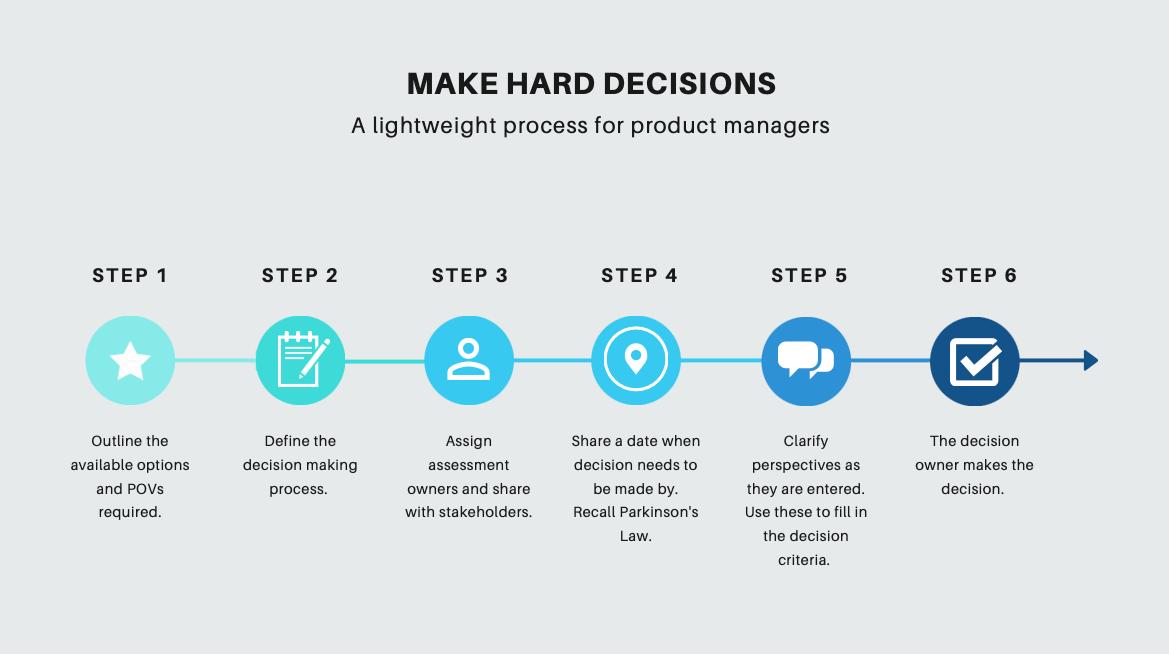My Template for Making Product Decisions
Use this lightweight process to drive cross-org product decisions
There are points in developing a product where a decision needs to be made. Here are a few examples:
We haven't got sustainable growth for this feature. Do we kill it?
We need to expand into our first international market. Which do we choose?
Our competitor launched a killer new feature. How do we respond?
Decisions like these are hard because there are many people involved. Creating a decision-making framework, capturing all of the right perspectives and forcing a decision is tough — but it's a common responsibility for the PM.
I was in this spot often on the WhatsApp Payments team. Given the complexity of launching consumer payment products in global markets, there were many big decisions that needed to be made all the time.
One memorable decision was which license we should operate under in an important market. There were policy considerations, marketing concerns, partners who were voicing their opinion and technical challenges to boot.
I used the following framework to drive an answer. Below, I’ll discuss why this lightweight framework works and how you can use it to answer more challenging and ambiguous questions.
⚖️ What makes a good decision-making framework?
Transparent criteria: a framework like the one above communicates how the decision will be made ahead of time. This allows people to align on what is important.
Involves all relevant stakeholders: people want to feel included in the process. This framework lets people include their perspective and is involved in the final outcome
Create objectivity: Because everyone's opinion is captured in a central place, people can objectively compare and contrast the perspectives. It will be clear that there was no favouritism or politics involved.
🔒What needs to be captured when making a decision?
Decision criteria: These are columns you can add to the framework that communicate the important differences between the options. The PM should add these and make sure they are accurate.
Options: Create a set of mutually exclusive, collectively exhaustive (MECE) options. This will let people share opinions on all possible paths forward, not just the one that they are championing.
Points of View: This the net-new addition to this framework that I love. It lets everyone voice their opinion, see each other's perspective and gain empathy for all sides of the argument.
Accountability for the assessment: Assign owners to each point of view so there is accountability on who is responsible for sharing the POV.
Decision owner: finally, all decisions should have someone responsible for making the final decision. This is often the PM but it can also be the lead for the given area.
🪜 Steps to use this framework for your own decisions:
When a decision needs to be made, outline the MECE options and the points of view that are necessary.
Define the decision-making criteria. These are the factors that will decide which option is best. Some examples include addressable market, engineering effort or price.
Assign points of view to an owner. Share the framework with stakeholders who are interested in the decision outcome. This creates broader visibility into the decision-making process and creates accountability for the points of contact.
Share a date when this decision needs to be made. When in doubt, bias towards less time. Recall Parkinson's Law - a decision will take as long as you give it time for.
While people add their perspectives, ask for more clarity or details where necessary. Each assessment should be clearly understandable to all stakeholders.
When the table is filled, the decision owner will need to weigh the opinions and criteria of each option. After this, the owner makes the decision and documents it for the stakeholders and POV owners. Here are two key points about this step:
Any decision will be more palatable now because there is objectivity and transparency around the whole process.
Partner with your manager or a trusted colleague to ensure you're seeing the full picture.
This process does more than make a decision. It creates transparency, trust and objectivity within your team. Used properly, this process can help you strengthen team culture and make your leadership more confident in your team’s abilities.
Summary
Use this lightweight decision framework to drive decisions across a large group of stakeholders. Lean on your team to share their perspectives and objectively weigh them against the decision criteria. Also, use the process of decision-making to build empathy and internal alignment with your stakeholders.
Try this framework next time you need to make a hard decision. ☺️
🖼 Internet Things I’m Enjoying
Integrated Apple and App Store Risk by Ben Thompson: Ben explains the consumer benefits of Apple’s integration play with software and risks to third-party developers.
The Cooperation Economy by Packy McCormick: In the Internet Age, cooperation is proving to be the dominant strategy. This is reinforced with web3 and the rise of digital communities.
Venture Education Center by AngelList: Ever wonder how venture capital actually works? AngelList launched a resource hub to shed light on the complicated field.
If you’re new to Product Life, subscribe below for concise, actionable and often surprising lessons for product managers.
Until next time,




Interesting framework Will - I think similar to your 'company tour' article about the first 30-60-90 days - a framework with actual example data (company agnostic) would be cool